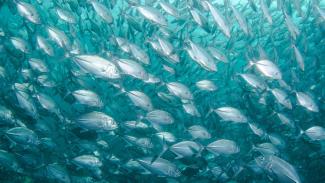Current affairs

Every diver has had experience dealing with currents - in some way they affect every single dive we make. Sometimes they are in our favour, providing a delightful drift dive.
Other times, they turn against us, making a dive difficult & strenuous. They have a big impact on marine life too, bringing nutrients that feed entire communities, from the corals themselves up to mighty Whalesharks.
But what is a current, where do they come from, where are they going and why?
Push & pull
Scientists normally divide currents into 3 broad groups: tidal currents, wind-driven currents & deep currents.
Tidal currents are linked to the pull of the sun & the moon. Everyone is familiar with the idea of tides and tidal currents follow a similar pattern. When the tide is rising, they flow in one direction. When the tide is falling, they flow in the opposite direction. If you have ever been on a dive and, part way through, the current sudden feels like it changed direction and got a whole lot stronger, this is more than likely a change in the tidal current, from a rising tide to a falling tide, or vice versa.
The moon has the greatest impact on tidal currents. While it is much smaller than the sun, it is also much closer to the earth. As a result, it has around twice the pull on our oceans as the sun. When the moon is new or full, tides are high and tidal currents are strong - known as spring and neap tides. When the moon is in its first and third quarters, the pull is weakest and tidal currents are therefore weakest, meaning the most ideal diving conditions.
The strength of a tidal currents is also affected by the geography of the land, creating a stronger current where the water is channeled. As South-East Asia has many thousands of islands, it also has many narrow channels that funnel and speed up tidal currents. in some areas, tidal currents can be so strong that certain sites can only be dived on particular tides. The strong currents created also carry a healthy flow of nutrients, which is one of the reasons this area has such a healthy marine community and such fantastic diving.
Wind-driven currents affect the seas and oceans on a global and local scale. On a global scale, the seas follow the Trade winds in huge cycle round the oceans, known as Gyres. These wind-driven currents, or Gyres, exist in both the northern and southern Atlantic, the northern & southern Pacific and the Indian Ocean. Surprisingly, the wind at the surface can cause currents at depths of up to 400m, as each layer of the ocean 'drags' the layer below.
On a local scale, winds create waves which break when they meet shallow coastlines, creating currents such as longshore drift - a current that runs parallel to the shore, and rip currents, - short but powerful currents that run away from the shore.
Winds are also responsible for up-wellings and down-wellings. Up-wellings are especially important for marine life & therefore diving. They occur when the wind pushes water away from a part of the sea. The sea responds by pushing water up from the depths to replace the water blown away by the wind. As a general rule, cold waters from the bottom of the sea carry much more nutrients than warm surface waters. This means that when there is an up-welling, it brings lots of food and nutrients and attracts lots of marine life, meaning very good diving. This is why dive sites near deep water, such as oceanic atolls & islands are so rich in life.
Down-wellings are the exact opposite of up-wellings, where winds force water to build up in an area and force the water down. They can sometimes create dangerous down-currents, shich divers should be very wary of.



